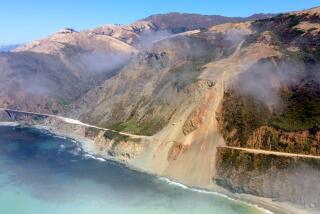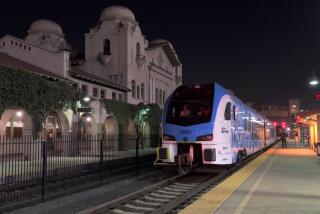Trains Run Again on Rail Line Closed by San Clemente Slide : Transportation: Freight and commuter service is restored between L.A. and San Diego after longest interruption in a century.
DANA POINT — A critical stretch of railroad, closed since a massive landslide two weeks ago, reopens to commuter trains early this morning, Santa Fe Railway officials said Monday.
The tracks were also expected to reopen by late Monday night to freight trains heading south to San Diego, which has been cut off from rail shipments since the Feb. 22 slide, officials said.
The good news for Amtrak commuters and for freight shippers dealing with everything from lumber to poultry feed comes less than a week after work crews began clearing tons of landslide debris from the Los Angeles-to-San Diego line. An estimated 2,000 cubic yards of dirt and rocks--about 18 feet deep in some sections--have been cleared since work started last Wednesday, officials said.
Most of the work has involved building a 300-foot-long retaining wall along the slide area between the tracks and the highway to prevent debris from sliding onto the lines. The wall is about 20 feet high and is supported by 44 steel girders, which are sunk up to 40 feet into the ground.
“The weather has been cooperative, and crews have been working around the clock,” said Mike Martin, a spokesman for the Atchison, Topeka & Santa Fe Railway. “And we haven’t had any problems.”
Since the landslide destroyed five ocean-bluff homes in San Clemente and sent tons of debris onto Coast Highway and the Los Angeles-to-San Diego rail line below, Amtrak commuter services have been disrupted and freight shipments have been unable to reach San Diego County.
“It’s safe to say this is the longest time that main line has been closed down since it was opened in 1888,” Martin said.
Before the slide, Amtrak provided service for more than 5,000 riders on 18 daily runs between San Diego and Los Angeles. With the closure, ridership dropped between 50% and 75% as commuters in San Diego and South Orange counties had to use shuttle buses to reach the Irvine Transportation Center, Amtrak spokesman Bruce Heard said.
“It’s not ideal any time you offer a substitute service, but we felt it was better than leaving passengers without any service,” Heard said. “But our business is trains, not buses. We’re glad to be back.”
Another section of track, this one outside San Juan Capistrano, was closed temporarily during a downpour on Feb. 26 when the banks of the swollen Oso Creek eroded within 30 feet of the rail line. That problem, which also has been corrected, affected two daily Amtrak commuter trains originating in San Juan Capistrano.
As crews continued Monday to clear the last of the debris from the tracks in Dana Point, just north of Camino Capistrano and Coast Highway, an empty Amtrak train traveled north from San Diego twice to help clean rust and corrosion from the tracks, said G.T. “George” Truitt, a regional manager for Santa Fe.
“The tracks will be all shiny again in the morning,” Truitt said.
Except for the rust, the tracks sustained minimal physical damage from the slide, Truitt said. Some rails were knocked on their sides when a highway divider hit them, but the repair work was proceeding without difficulty Monday, Truitt said.
The cleanup has cost the railroad about $350,000, officials said. Losses in freight revenue are expected to run into the “hundreds of thousands of dollars,” Santa Fe spokesman Martin said. Normally, two freight trains, one in each direction, travel between Los Angeles and San Diego each day.
Meanwhile, railroad and Dana Point officials have been keeping close watch on the slide area and say there hasn’t been any movement since work started to clear the tracks.
But for the time being, as a precautionary measure against excess vibrations, trains will travel only 20 m.p.h. through the slide area, Truitt said. Trains normally reach speeds of 60 to 90 m.p.h. on that stretch of tracks.
Starting today or Wednesday, Dana Point officials will begin test borings into the slide area above the highway, said Andy Anderson, emergency services coordinator.
Like similar tests completed recently up on La Ventana where the five homes were destroyed, the borings will be big enough for a geologist to be lowered into the ground, he said.
More to Read
Sign up for Essential California
The most important California stories and recommendations in your inbox every morning.
You may occasionally receive promotional content from the Los Angeles Times.









